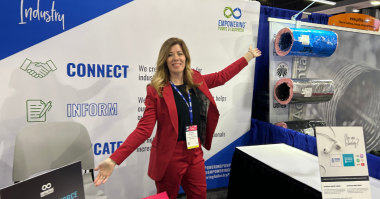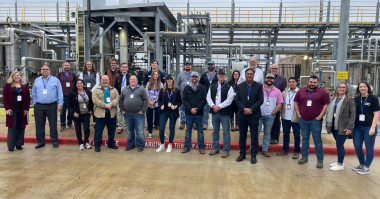More than 60,000 industry professionals showed up at the 85th International Air-Conditioning, Heating, Refrigerating Exposition (AHR Expo) to discuss cutting-edge developments and advancements in the HVACR industry.
The buzz from the showroom floor this year included newly released DOE regulations for circulator pumps, as well as the growing interest in the building services market, energy efficiency, new cooling requirements, a growing variable frequency drive market, and new advancements in heat exchanger technology. A trend of automatic data acquisition through smart instrumentation was also showcased.
Heating equipment remains an ever-evolving arena for innovation and technological advancement while indoor air quality also continues to be a target for new technology, as well as software solutions.
DOE Regulations for Circulator Pumps
A big item of discussion from the showroom floor was how the Department of Energy (DOE) issued the notice to formalize its intentions regarding circulator pumps, which were excluded from the commercial and industrial pump energy conservation standard, recently published in the federal register on January 26, 2016. The Hydraulic Institute (HI) Circulator Pump Committee has been informally negotiating with Energy Advocates and will continue to support the ASRAC working group.
The ASRAC working group will collect performance and sales data, negotiate and develop scope, test procedure, performance rating metrics and standard performance levels for circulator pumps at a formal meeting in Washington, D.C., on March 3, 2016. To attend the March 3rd public meeting in person email asrac@ee.doe.gov.
The Hydraulic Institute led the effort to facilitate the data gathering and standards development required for the Appliance Standards and Rulemaking Federal Advisory Committee (ASRAC) negotiated energy conservation standard and test procedure for Commercial and Industrial Pumps (CIP). The proposed CIP rule will eliminate the least efficient 25 percent of CIPs and includes performance metrics for constant speed equipment with no controls and for variable speed equipment with controls, acknowledging the benefits of the system approach to reducing energy.
As a result of the CIP ASRAC negotiations certain pump types were excluded from the proposed rule. One of the excluded pump types is circulator pumps, which are relatively small centrifugal pumps designed for hydronic systems where only pipe friction head must be overcome.
Building Services Maintenance Market
Revenues for contract (non-proprietary) building maintenance services will rise 4.3 percent per year through 2017 to $176.5 billion, according to a market research study from Freedonia. Pest control and interior building cleaning will be the fastest growing services, while landscaping remains the largest type of service. The residential market should outpace nonresidential demand.
Freedonia’s study analyzes the $143 billion U.S. building maintenance service industry. It presents historical demand data for the years 2002, 2007 and 2012, and forecasts for 2017 and 2022 by service (e.g., landscaping, interior building cleaning, pest control, street and parking lot cleaning and maintenance, exterior building cleaning, swimming pool cleaning and maintenance), market (nonresidential, residential) and U.S. geographic region.
Outlook of the Global HVAC Market
The increase in construction activities worldwide is a key growth driver for the HVAC market, according to Technavios research analysts, who predict the global HVAC market to grow steadily at a CAGR of 7% during the forecast period.
New construction in the residential, commercial, and industrial sectors have increased the demand for HVAC systems, which improves building efficiencies and generates high revenue for the market. Government regulations introduced by countries worldwide compel HVAC system vendors to comply with industry standards. The Commercial Building Disclosure outlined by the Australian government provides a high incentive for improving the performance and efficiency of HVAC systems. It requires building owners selling or leasing office spaces larger than 2,000 square meters to comply with energy efficiency standards. This, in turn, has been encouraging the installation of efficient HVAC systems.
Advances in monitoring systems and intelligent technology are expected to contribute to the growth of the HVAC market, according to the report. Monitoring systems help in tracking the energy consumption of a building while intelligent technology controls the energy output of an HVAC system. The integration of the Internet of things (IoT) with HVAC systems is also opening new revenue avenues for the HVAC market.
The HVAC equipment segment dominated the market during 2015, with a market share of around 69%. The growing population and industrialization, rising sales of domestic and commercial buildings, increasing construction expenditure, and the expanding purchasing power of the middle class are the key growth drivers for this segment.
The non-residential segment accounted for 67% of the market share during 2015, according to the report. Healthcare and educational institutions, manufacturing and industrial buildings, as well as offices and retail stores are the non-residential users of HVAC systems.
Variable Frequency Drive Market Growing
The global variable frequency drives (VFDs) market is forecast to grow steadily at a compound annual growth rate (CAGR) of nearly 8% by 2020, according to a report from ReportsnReports. Source: http://www.achrnews.com/articles/131601-variable-frequency-drives-market-to-grow-at—cagr-by–
VFDs are increasingly being applied in HVAC systems as energy management tools, and the prospects for growth in this market are being driven by the growing demand for electric motors in various applications. VFDs act as energy-saving devices in fans, pumps, air handling units, and chillers. They are increasingly used in equipment having variable load applications. Typically, energy savings vary from 30 percent to 50 percent when using a VFD.





Comments